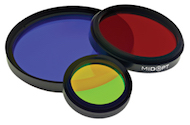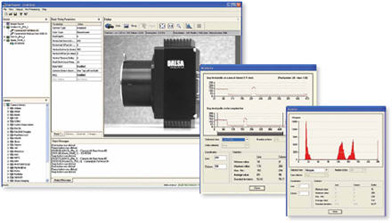Machine vision and industrial imaging systems systems are used in various applications ranging from automated quality control inspection, bottle filling, robot pick-and-place applications, autonomous drone or vehicle guidance, patient monitoring, agricultural irrigation controls, medical testing, metrology, and countless more applications.
Imaging systems typically include a least a camera and lens, and often also include one or more of specialized lighting, adapter cards, cables, software, optical filters, power supply, mount, or enclosure.
This resource page is intended to make sure that nothing in a planned imaging application has been missed. There are many aspects on which 1stVision can provide guidance. The main components to consider are indicated below.

Camera: A digital camera with a CMOS or other sensor converts photons into charge values as pixels – picture elements – an array of values representing light intensity. Many applications require only monochrome images – in grayscale. Others use color sensors or thermal imaging, but the principle of converting analog light into digital values is common across all cameras.
There are area scan cameras for visible, infrared, and ultraviolet light, used for static or motion situations. There are line scan cameras, often used for high-speed continuous web inspection. Thermal imaging detects or measures heat. SWIR cameras can identify the presence or even the characteristics of liquids. The “best” camera depends on the part of the spectrum being sensed, together with considerations around motion, lighting, surface characteristics, etc.

Lens: The lens focuses the light onto the sensor, mapping the targeted Field of View (FoV) from the real world onto the array of pixels. One must consider image format to pair a suitable lens to the camera. Lenses vary by the quality of their light-passing ability, how close to the target they can be – or how far from it, their weight (if on a robot arm it matters), vibration resistance, etc. See our resources on how to choose a machine vision lens. Speak with us if you’d like assistance, or use the lens selector to browse for yourself.

Lighting: While ambient light is sufficient for some applications, specialized lighting may also be needed, to achieve sufficient contrast. And it may not just be “white” light – Ultra-Violet (UV) or Infra-Red (IR) light, or other parts of the spectrum, sometimes work best to create contrast for a given application – or even to induce phosphorescence or scatter or some other helpful effect. Additional lighting components may include strobe controllers or constant current drivers to provide adequate and consistent illumination. See also Lighting Techniques for Machine Vision.

Optical filter: There are many types of filters that can enhance application performance, or that are critical for success. For example a "pass" filter only lets certain parts of the spectrum through, while a "block" filter excludes certain wavelengths. Polarizing filters reduce glare. And there are many more – for a conceptual overview see our blog on how machine filters create or enhance contrast.

Interface adapters: For some applications, to transfer image data and camera controls between the host computer and the camera, one needs either a frame grabber or host adapter. We provide an overview of camera interfaces, or will be happy to discuss it with you.

Cables: Just as with chains, the weakest link is a potential point of failure or underperformance. Don’t let your cable be a weak link in your system. Besides needing the correct pin-out at both the camera and host ends, cables vary by intended length, whether static or repeatedly flexed, performance in electromagnetic fields, and other characteristics. What cables should I use?

Software: Many camera manufacturers include a comprehensive software development kit (SDK) at no added cost to the buyer. Other users prefer the features or familiarity of a third-party SDK. It all depends on how one wants to control the camera(s), one’s programming skills and experience, and the speed and complexity of the imaging application.

Power supply: Cameras need to be powered, so while some are now powered by power-over-ethernet (PoE) or USB, which are hybrid power/data cables, others must be directly powered by an adapter with the correct voltages and pin-outs.

Tripod: To insure a stabile camera position, will you mount it to your own apparatus or do you need a tripod or mounting hardware?

Enclosure: Some applications find the camera in a dry, moderate temperature environment. But others must place the camera where it would be out in the weather or in a wash-down environment, requiring protection from moisture via a housed enclosure.
Whatever your application, we take pride in being the distributor with a reputation for adding value by guiding our customers to a comprehensive solution. Contact us if you would like more information.